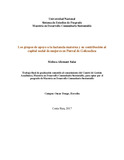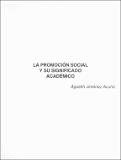| dc.contributor.advisor | Moreno Díaz, Mary Luz | |
| dc.contributor.author | Jiménez Ureña, Francinie | |
| dc.date.accessioned | 2023-01-13T18:30:44Z | |
| dc.date.available | 2023-01-13T18:30:44Z | |
| dc.date.issued | 2022-12-12 | |
| dc.identifier.uri | http://hdl.handle.net/11056/24516 | |
| dc.description.abstract | La investigación que se realizó está orientada en vislumbrar los principales cuellos de botella que afectan a vinculación y la permanencia de los trabajadores independientes dentro de la seguridad social de Costa Rica, con el objetivo de establecer mecanismos alternativos que fomenten la inclusión de esta población en el pago de las contribuciones sociales.
El análisis de la investigación que se desarrolló corresponde a un caso de estudio de los trabajadores independientes de la Región Central que se encuentran activos en el último, para poder definir las perspectivas que tiene la población objetivo con respecto al Seguro de Salud (SEM) y del Régimen de Invalidez, Vejez y Muerte que administra la Caja Costarricense de Seguro Social (CCSS). Asimismo, para realizar la caracterización socioeconómica y demográfica de la población, se consultaron los datos de la Encuesta Continua de Empleo (ECE) y la Encuesta Nacional de Hogares (ENAHO) que publica el Instituto Nacional de Estadística y Censos (INEC).
Se sintetizaron los principales mecanismos de aseguramiento que se utilizan en otros países específicamente orientados a los trabajadores independientes, para establecer aspectos de mejorar que se puedan implementar a nivel país. En el caso del mecanismo de aseguramiento actual aplicado en el país, se procedió a identificar las modificaciones realizadas al método, así como los puntos que todavía se podrían detallar a un más dentro del reglamento aplicado.
A partir del método empleado en la investigación, se lograron obtener consideraciones relevantes que interfieren en el pago de las contribuciones sociales por parte de los trabajadores independientes, tales como: el monto que pagan adeuda cuotas, cobros retroactivos y otros. Por su parte, a pesar del esfuerzo de la institución por flexibilizar el método actual, no se ha logrado tener un impacto positivo en la población objetivo, que fomente la inclusión de una mayor proporción de trabajadores a la seguridad social.
Con los resultados obtenidos, se proponen alternativas al método actual, con el fin de incentivar a los trabajadores independientes a inscribirse a los regímenes de la CCSS y, al mismo tiempo, que la institución pueda aumentar sus ingresos vía contribuciones sociales. | es_ES |
| dc.description.abstract | The research that was carried out is aimed at glimpsing the main bottlenecks that affect the linkage and permanence of independent workers within the country's social security, with the aim of establishing alternative mechanisms that promote the inclusion of this population in the payment of social contributions.
The analysis of the research that was developed corresponds to a case study of the independent workers of the Central Region who are active in the latter, to define the perspectives that the target population has regarding Health Insurance and the Social Security Regime. Disability, Old Age and Death administered by the Costa Rican Social Security Fund (CCSS). Likewise, to carry out the socioeconomic and demographic characterization of the population, data from the Continuous Employment Survey (ECE) and the National Household Survey (ENAHO) published by the National Institute of Statistics and Censuses (INEC) were consulted.
The main insurance mechanisms used in other countries specifically oriented to independent workers were synthesized, to establish aspects of improvement that can be implemented at the country level. In the case of the current insurance mechanism applied in the country, the modifications made to the method were identified, as well as the points that could still be further detailed within the applied regulation.
From the method used in the investigation, it was possible to obtain relevant considerations that interfere in the payment of social contributions by independent workers, such as: the amount they pay, due fees, retroactive collections, and others. For its part, despite the institution's efforts to make the current method more flexible, it has not been able to have a positive impact on the target population, which would encourage the inclusion of a greater proportion of workers in social security.
With the results obtained, alternatives to the current method are proposed to encourage independent workers to enroll in the CCSS schemes, and at the same time that the institution can increase their income through social contributions. | es_ES |
| dc.description.sponsorship | Universidad Nacional, Costa Rica | es_ES |
| dc.language.iso | spa | es_ES |
| dc.publisher | Universidad Nacional, Costa Rica | es_ES |
| dc.rights | Acceso abierto | es_ES |
| dc.rights.uri | http://creativecommons.org/licenses/by-nc-nd/4.0/ | * |
| dc.subject | TRABAJADORES INDEPENDIENTES | es_ES |
| dc.subject | SEGURIDAD SOCIAL | es_ES |
| dc.subject | INDEPENDENT WORKERS | es_ES |
| dc.subject | HEALTH INSURANCE | es_ES |
| dc.subject | ASSURANCE | es_ES |
| dc.subject | SOCIAL SECURITY | es_ES |
| dc.subject | SALUD | es_ES |
| dc.subject | COSTA RICA | es_ES |
| dc.subject | INCLUSIÓN SOCIAL | es_ES |
| dc.subject | HEALTH | es_ES |
| dc.subject | SOCIAL INCLUSION | es_ES |
| dc.title | Métodos Alternativos para el aseguramiento de los trabajadores independientes que permitan una mayor inclusión al sistema de seguridad social en Costa Rica | es_ES |
| dc.type | http://purl.org/coar/resource_type/c_bdcc | es_ES |
| dc.description.procedence | Centro Internacional de Política Económica para el Desarrollo Sostenible | es_ES |



